Review: Does the Broad’s new Jasper Johns exhibition hit the bull’s-eye? It gets darn close
Jasper Johns is an iconic iconoclast. Working at cross-purposes has certainly been productive: At 87, he is among our greatest living artists.
In graphics, sculptures and especially paintings made over the course of more than 60 years, his work has doggedly torn apart cherished artistic assumptions while managing at the same time to convey profound, often tender regard for them. Death, the specter of mortality, is here essential to making art that lives.
The much-anticipated survey of Johns’ career at the Broad in downtown Los Angeles opens with a marvelous example — one of his best-known. “Painting With Two Balls” (1960) is a gleeful Neo-Dada joke.
Johns inserted two golf-ball-size spheres into a space pried open between two of its three colorful, vigorously brushed abstract panels. Mocking Abstract Expressionism, for a decade art’s dominant language, the painting takes literally the macho New York School demand for a “ballsy” art.
You want a painting with balls? Here’s one.

It’s also much more than that. Whether in his images of the American flag, the map of the United States, targets, numbers or letters of the alphabet, Johns never just paints one-liners. The gap where the balls are inserted reveals what lurks behind painted gestures — which is to say: nothing, save for the mundane wall on which the painted object hangs.
“Painting With Two Balls” began with a layer of torn newspaper pages, physically shredding topicality as the painting’s foundation. On top of the collage element, brushwork is applied edge to edge with what could be called “delicate energy.” A flurry of ragged, peppy strokes in rainbow hues — plus black, white and gray — is rendered through evident gestures of the wrist and forearm but without the action of the entire body.
Johns doesn’t put his entire body into the action of painting for a simple reason: The painting is the body.
At just over 5 feet high and 4 feet wide, the object corresponds to the physical presence of a viewer standing before it. Mixing pigment into wax — an encaustic technique traced to ancient Egypt, though rarely employed in contemporary art — creates a lumpy, optically veiled surface. All the tropes of Abstract Expressionism seem to be embalmed, like something from Madame Tussauds. No wonder those North African ancients chose encaustic specifically for mummy portraits.
The painting’s title and the artist’s signature hug the breadth of the bottom edge, spelled out in machine-stenciled letters that negate this most intimately tailored sign of the artist’s hand. As if to emphasize the distinction, the only hand-rendered element is the date, 1960 — a personalized marker in time. Like the two balls squeezed into the painting, the year is wedged in between the title and the signature.
It’s thrilling to watch the thoroughness with which Johns works his way through the conventions of then-dominant Abstract Expressionist painting, dismantling them one by one and remaking them into something new and unforeseen. What the critic Clement Greenberg championed as “American-type painting” to distinguish it from European abstraction before World War II, Johns proceeded to create as U.S. flags and national maps.
What’s the difference between a painting of a flag or map and an actual flag or map? Nothing, really. Together with Robert Rauschenberg, his romantic partner at the time, Johns launched a critique of pure abstraction that changed art’s direction.
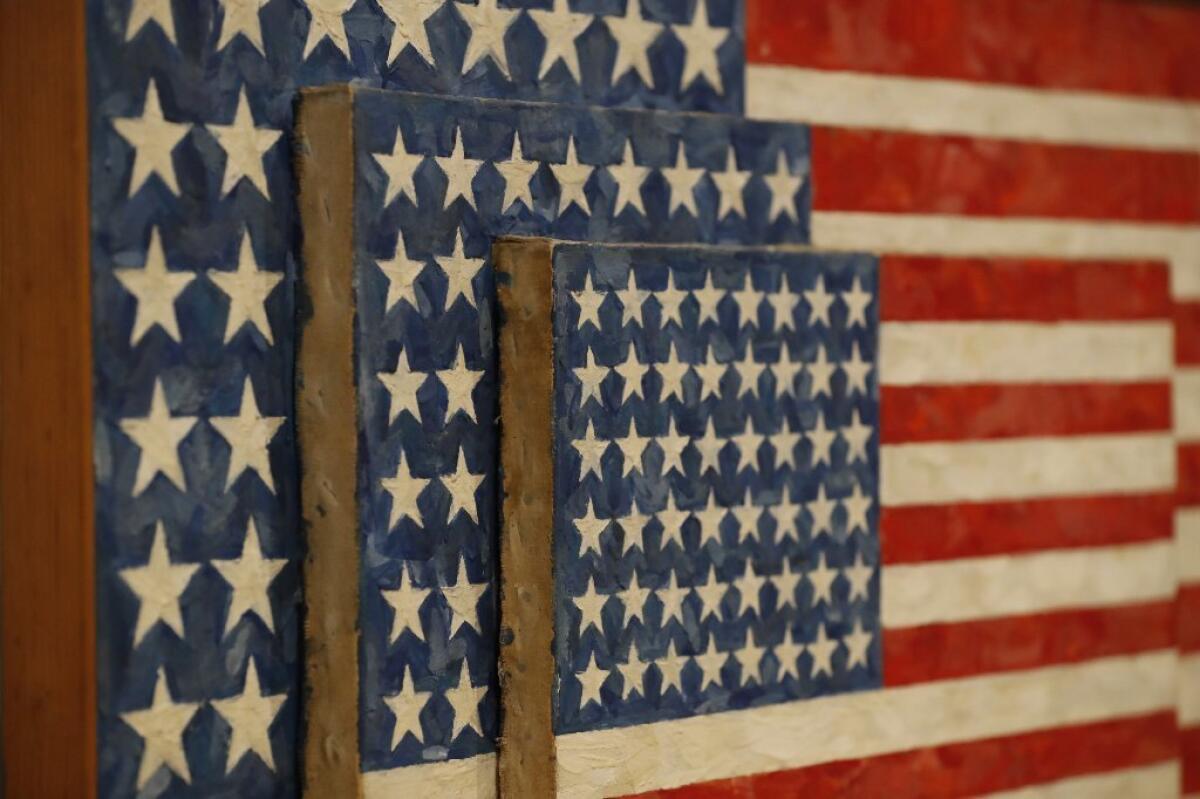
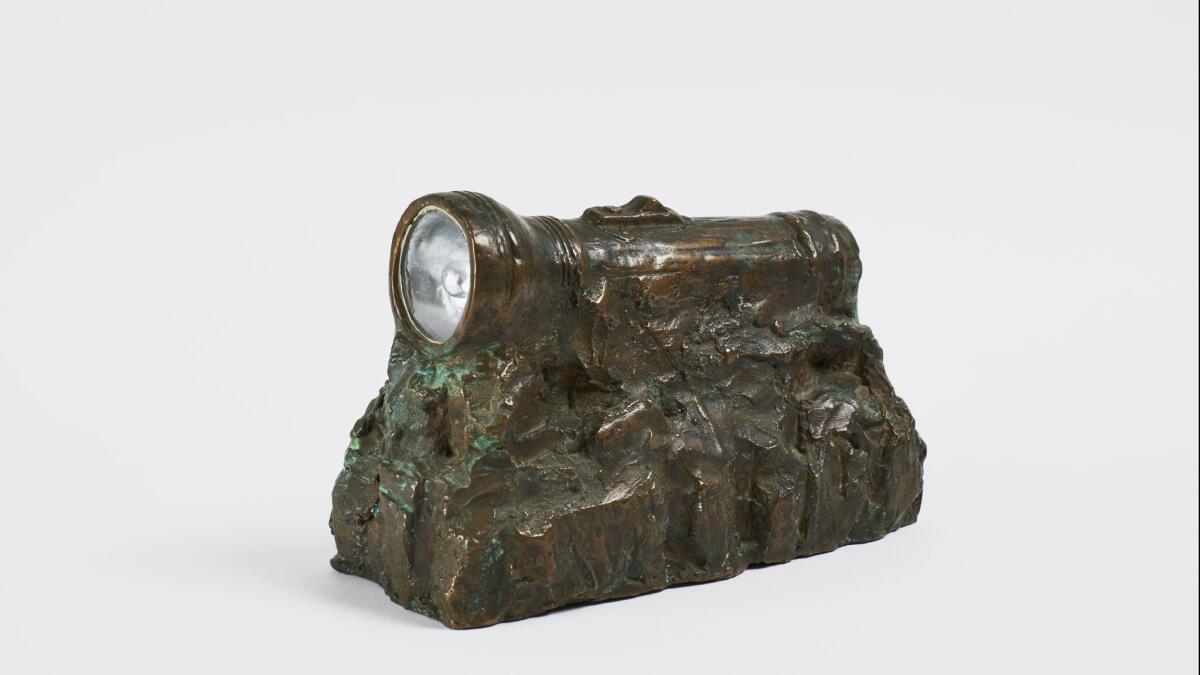
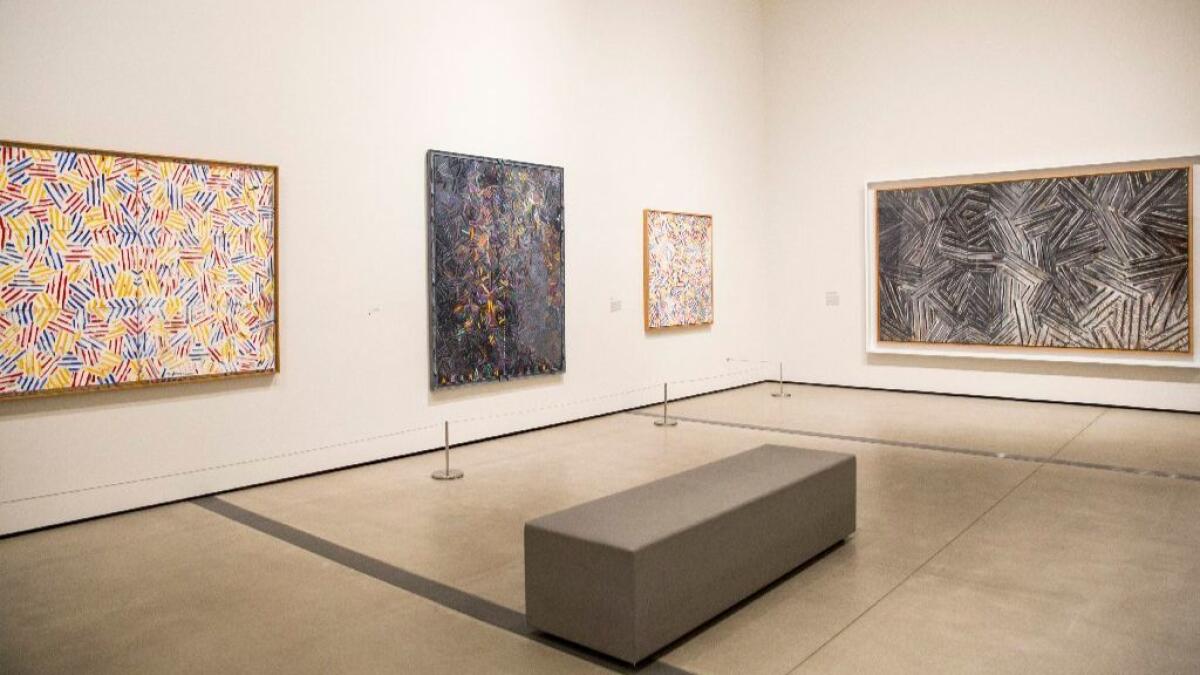
A flag and a map are abstractions — but not exactly in the way critics or artists like Jackson Pollock and Barnett Newman might mean. So is a target, which in Johns’ hands fused the competing wings of Abstract Expressionism with “gestural geometry.” And if avant-garde art downgraded figurative painting to a minor rank below abstract art, what was one to do with paintings of numbers — which is to say, figures — that epitomize abstraction?
These and other wry aspects of Johns’ remarkable work unfold throughout the exhibition.
Initially organized for London’s Royal Academy of Art last fall by curator Edith Devaney and art historian Roberta Bernstein, whose five-volume catalogue raisonné of the artist’s work was published last year by Yale, it is presented here by Joanne Heyler and Ed Schad, the Broad’s director and curator, respectively. It’s slightly trimmed — more than 120 works, rather than 150 or so in London — and sometimes a bit crowded in galleries not as ample as those at the Royal Academy. Regardless, it’s not to be missed.
The show is not a retrospective. (The Philadelphia Museum of Art and New York’s Whitney Museum are jointly organizing a retrospective for 2020.) Too many major examples are missing for that.
Among them are the big, color “Map,” which would have been great to see paired with the darkly magnificent gray version loaned by the Broad’s downtown neighbor, the Museum of Contemporary Art; “Diver,” a poetic eulogy to writer Hart Crane, with the artist’s hands literally diving into a blackened sea of charcoal and pigment; and “Target With Four Faces,” a mixed-media work that juxtaposes a red-yellow-blue bull’s-eye with four three-dimensional casts of an eyeless face. All are in the collection of the Museum of Modern Art.
Also absent is “Painted Bronze/Ale Cans,” the tabletop sculpture of two cans of Ballantine Ale, one sealed (and presumably full) and the other opened (and visibly empty). The sculpture, an intoxicating conundrum, presents identical imitations of an actual beer can that also copy each other — except, of course, for that minor problem of whether an industrially mass-produced copy is empty or full.
Ancient Greek sculptures were also painted, and it was Plato and Aristotle who first argued over the relative merits of art as imitation. (I like thinking of the philosophers as disputatious beer cans.) In an exquisite group of Johns’ small, densely modeled and darkly patinated bronze sculptures of light bulbs and flashlights, vaporous ideas pretending to illuminate the darkness are batted down.
“No ideas but in things,” as poet William Carlos Williams put it. Another sculpture of painted bronze paintbrushes stuffed into a painted bronze coffee can seals the deal, exalting ordinary stuff in an artist’s studio.
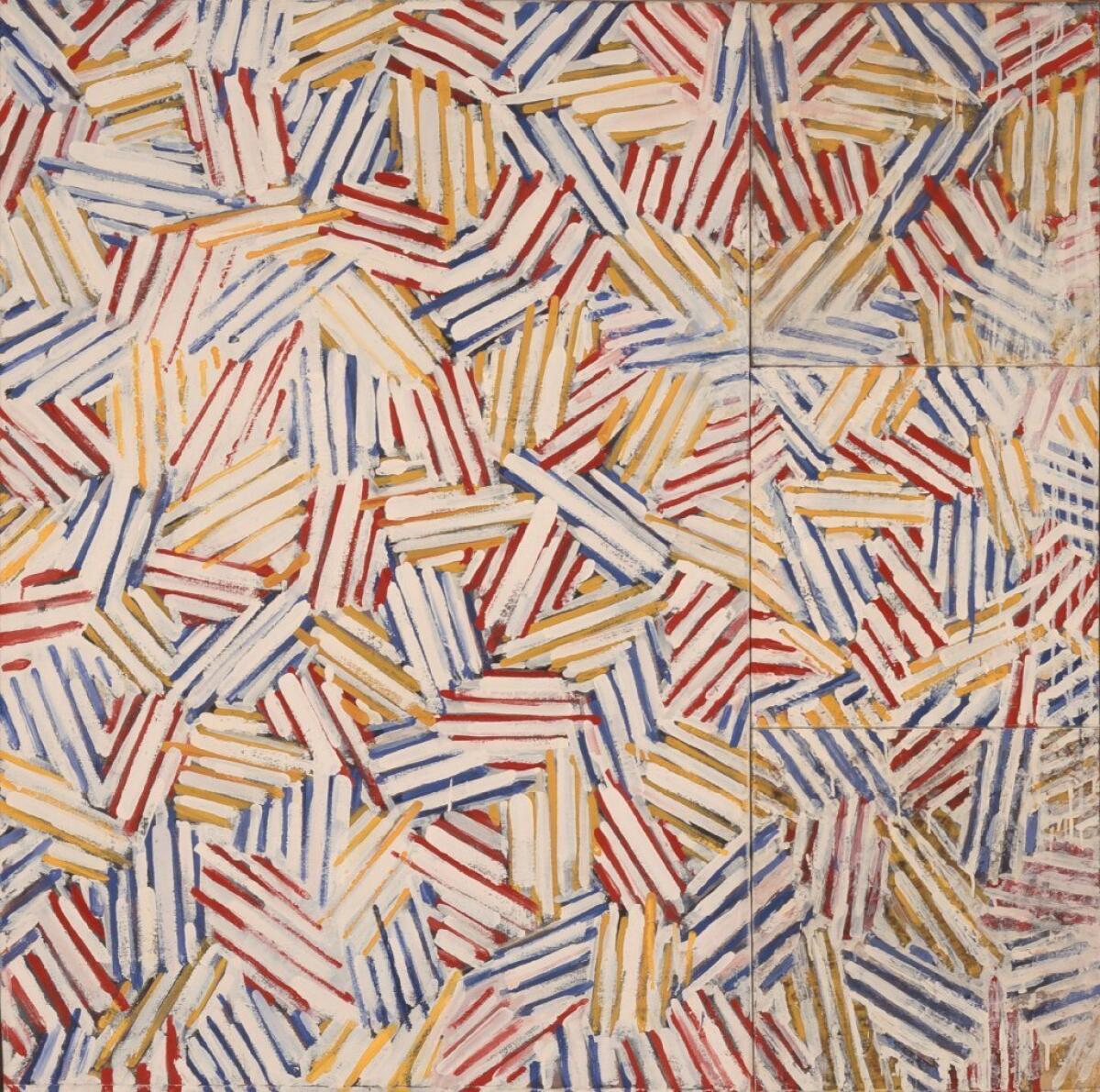
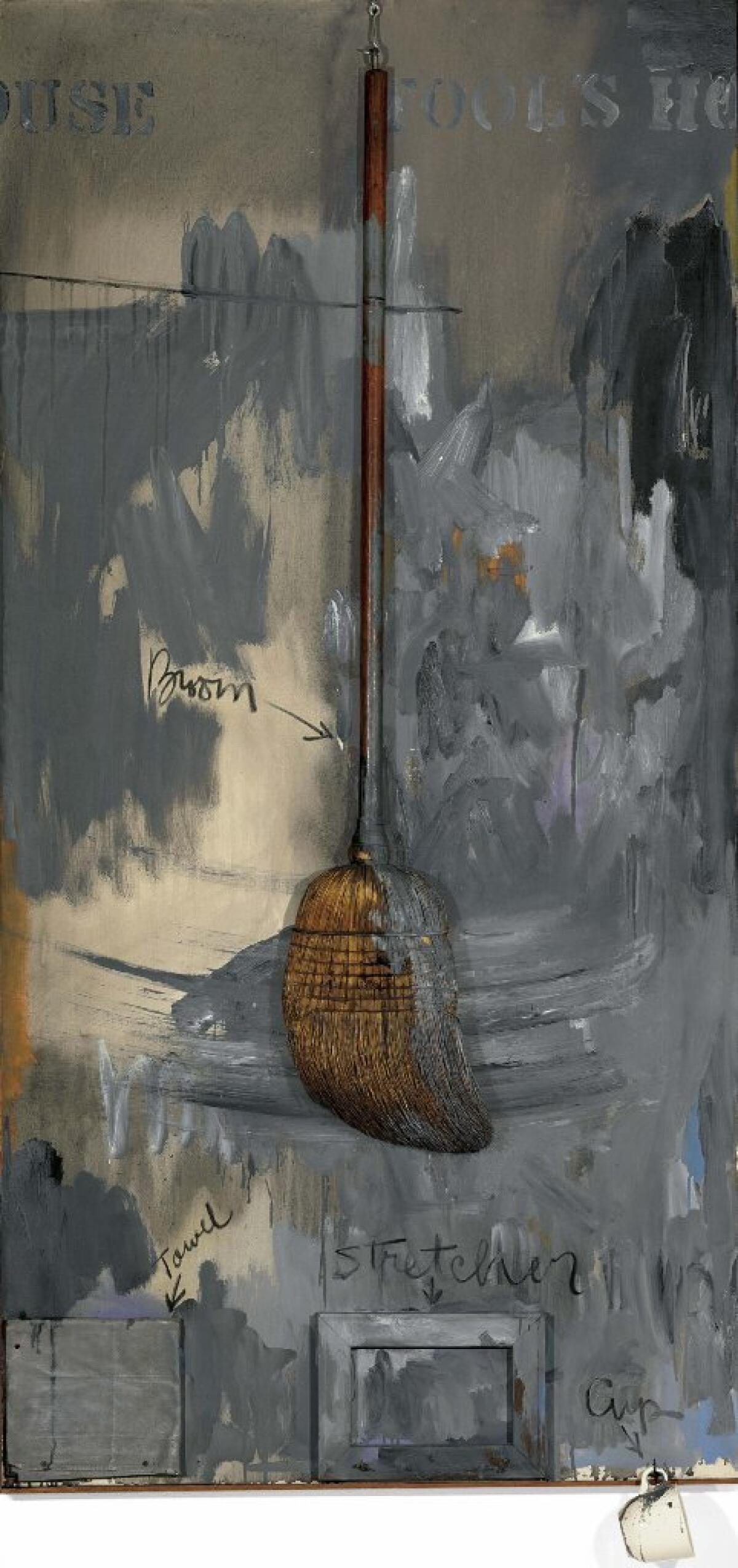
So there is plenty here to like — including individual stunners like “False Start” and “Fool’s House,” which embody the anxiety of an artist in the studio faced with a blank canvas, plus a roomful of eight so-called “crosshatch” paintings and drawings. Their obsessive patterning of parallel lines is typically used by graphic artists to represent light and space, which actually shimmers in Johns’ paintings.
The survey is thematic, which is also illuminating. Eight sections examine such topics as “Painting as Object” and “Time and Transience.” Works from different decades and in various media are assembled to demonstrate career-long preoccupations. By the last gallery you’ll have a pretty good handle on a famously inscrutable body of work.
The highlight of a section on art and language, for example, is the 1976 artists’ book, “Foirades / Fizzles,” featuring five enigmatic text fragments in French and English by Samuel Beckett and 33 prints by Johns. Beckett’s writing alludes to people and places in earlier books and plays, while Johns does something similar with fragments of other art a viewer will likely have encountered elsewhere in the show. Art’s world lives outside conventional time and space.
Johns’ work went through a bit of a rough patch in the decade between the mid-1980s and the mid-1990s, when the paintings took a deeply inward, almost claustrophobic turn. Paintings that borrow fragments from Picasso or center on an eccentric puzzle- shape seem obscure for no productive reason.
In the wake of his compelling 1996 MoMA retrospective, however, he pulled out of the slump by starting over. In large, elegant, uncluttered canvases that feature a simple length of string, Johns cleared his paintings’ decks.
The suspended string, attached at either end to wooden slats leaning out into space from the framing edge, forms a graceful catenary arch in front of the painted surface. Shadows of the curved line traverse the painting, establishing a gentle tension between the flatness of a canvas and the reality of curved space in Einstein’s universe.
Johns repeats the line in quietly agitated paint, a gesture that lodges art between object and ghost. Many also have a diamond pattern painted along one edge, invoking Harlequin — the mute joker in traditional pantomime. In “Catenary (I Call to the Grave),” everything is in shades of gray — scores of them, so that fading light seems to flicker through.
Almost inexplicably, the gentle catenary sag feels at once valedictory, melancholic, utterly confident and wholly natural. The masterful catenary paintings, still under-sung in Johns’ copious repertoire, are a powerful conclusion to a blissful show.

'Jasper Johns: "Something Resembling Truth" '
Where: The Broad, 221 S. Grand Ave., L.A.
When: Opens Saturday, ends May 13
Tickets: $25; free for 17 and younger; reservations recommended
Info: www.thebroad.org
christopher.knight@latimes.com
Twitter: @KnightLAT
The biggest entertainment stories
Get our big stories about Hollywood, film, television, music, arts, culture and more right in your inbox as soon as they publish.
You may occasionally receive promotional content from the Los Angeles Times.








